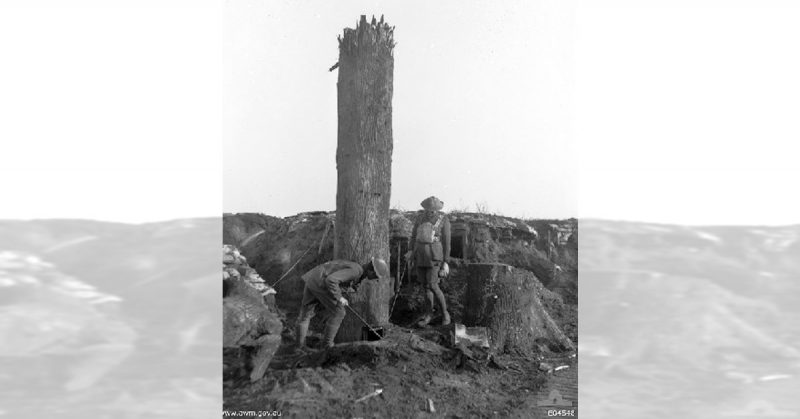Hunters and nature lovers have for hundreds of years used hides to enable them to get closer to their prey, so the concept of using natural surroundings to camouflage your position is not new. What is different was the extent to which British Army went to provide their forward observation with the most meticulous of hides; observation trees.
Observation trees had first been used during WWI by the French, who taught the British how to manufacture them and the first ‘observation tree’ was erected in 1915. The Germans also learned the trick, and soon both sides were using them to guide ground forces.
The process for creating one of these trees was meticulous in the extreme. The engineers would scout the front lines and select a dead tree, preferably one that had been damaged by shell fire. They would then set about scrupulously measuring, photographing and sketching the tree. Now they had their donor tree; they could set about making an exact replica of the original.
The duplicate would have identical measurements, the same broken and dead branches, the same bark, the same knot holes; in fact everything was identical to the smallest detail. The construction process was painstakingly carried out. First, the engineers constructed an armored shell that would provide some degree of protection for the soldier manning the post. This shell would be a little smaller than the original diameter of the tree as once the engineers had finished creating the protective inner, they would work with more artistic people to create the outer or bark which would provide the camouflage for the tree.
The bark would be built upon a frame that fitted around the tree, and it usually protruded a few inches above the top of the protective armored inner. Not only was the bark scrupulously built up to imitate the original bark, but there were also parts where there was no bark, just lighter sections that imitated the naked wood left behind when the bark had been blasted off by the explosives. The attention to detail was incredible. Bark was built up of many things, but the most common material appears to have been crushed seashells which were precisely colored and painted to match the original photographs taken by the engineers. The artistic covering included things such as lichen and moss that were found on the original tree.
Inside the armored shell, there was a very small rope ladder that led up to the observation seat located near the top. The ladder had rungs just large enough to fit a booted foot and the distance between the rungs measured around 12 centimeters apart. There was little room inside the shell so the soldier would not have been able to bend his knee very much, therefore the rungs had to be close together.
The observer had a metal seat with a wooden ‘cushion’ to sit upon. The tree was erected on a trench that allowed the observer access to the door at the base of the tree. As he climbed up the seat folded up to allow him past, and then folded down, so he had somewhere to sit. The top portion of the tree was slightly larger than the ‘trunk’ to allow the observer space to carry out his duties. There were also three observation holes covered with mesh that the observer used, in conjunction with a periscope, to view the troop movements on the ground.
Once the tree was assembled and ready to be erected, the engineers swung into action, assisted by the artillery battalions. The tree had to be erected at night and there needed to be a great deal of noise and distraction, so the enemy did not notice one tree leaving and another taking its place! Under cover of an artillery barrage, the engineers would chop down and dig out the original tree and replace it with their carefully crafted copy. By morning, no-one would be any the wiser that the tree looking out over no man’s land was a fake, manned by an eagle-eyed observer, Smithsonian reported.
The Australian War Memorial will be exhibiting a tree manufactured by the German Army during their Centenary Exhibition for WWI. Known as a Baumbeobachter, which translates to ‘tree observer,’ the tree was recovered by the Australian Army from the Oosttaverne Wood in Belgium. This wood was captured by the Germans in November 1914 and remained in German hands until the Allied Forces overran it on the 7th June 1917, at the start of the Battle of Messines. The tree was now about 3km behind Allied lines and was discovered by the Australians, who were amazed at what they had found. 3 Battalion AIF carefully dismantled the tree in January 1918 and took it back with them to Australia where it was handed over to what would become the Australian War Memorial. The tree still sports damage caused by shrapnel and bullets, a stark reminder of where it came from.
The soldiers involved in dismantling the tree had scratched their names or initials into the base of the tree. Sadly many of them are now indistinguishable due to age and rust, but there are still some that can be clearly read. One set of initials scratched onto the base reads ‘7028 HJM’, belonging to Private Harold John Meyn, who had a service number 7028. Meyn enlisted at age 22, in his hometown of Tamworth, New South Wales, and served with 3 Battalion and 1 Machine Gun Battalion. He survived the war.
This tree is a fascinating glimpse into the workings of the engineering battalions of the Army. We tend to think of the engineering battalions in terms of large works such as building bridges, but this tree proves that they were just as adept at producing finely crafted objects that had a hand in saving lives at the front.
